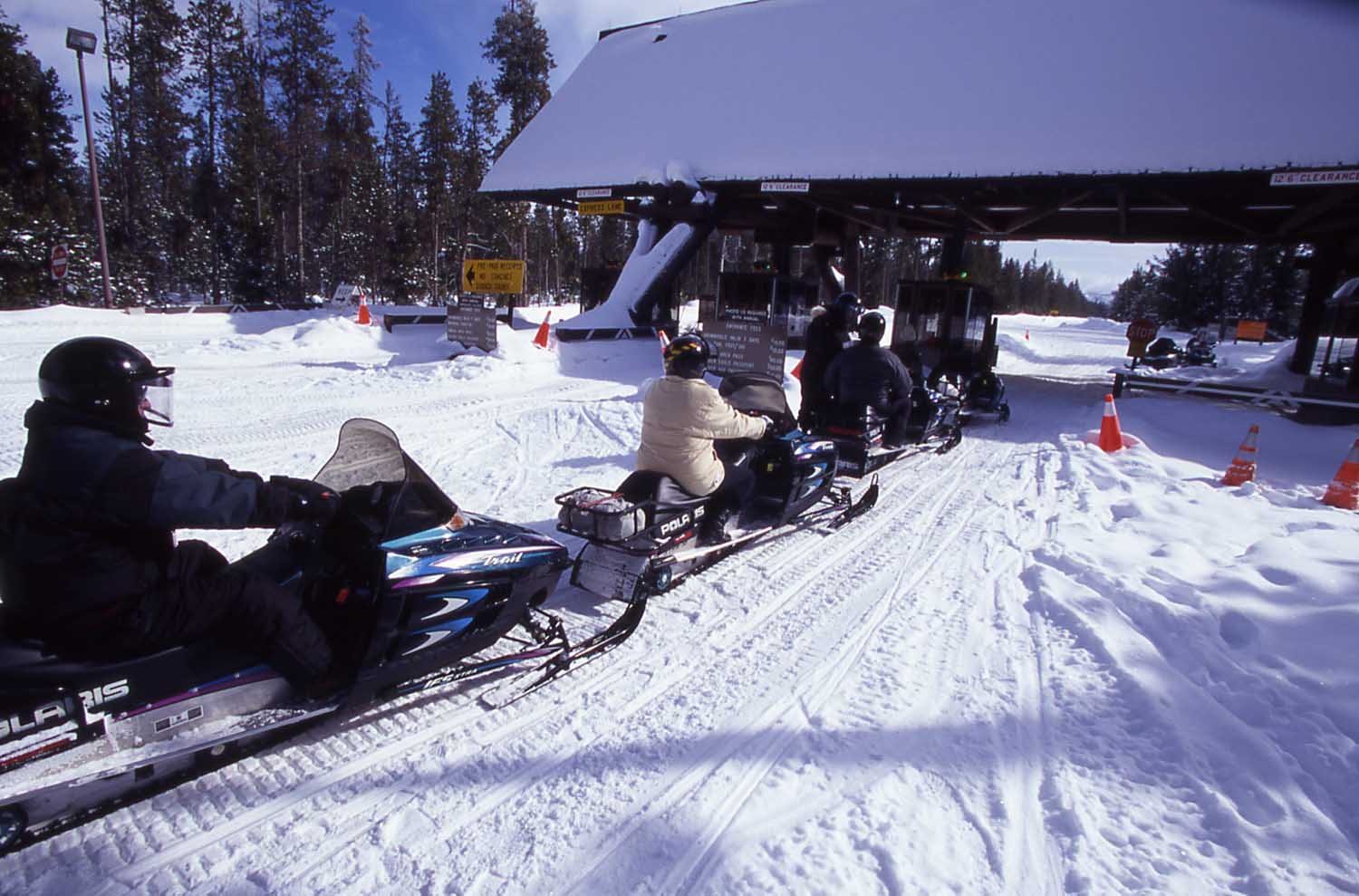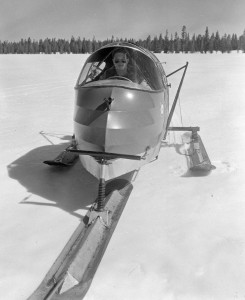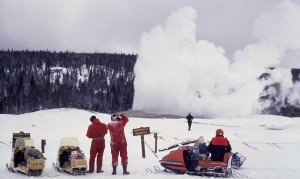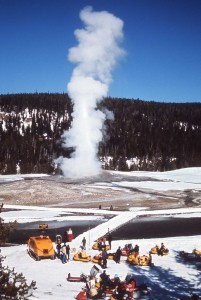
Snowmobile riders in 1998 line up at the West Gate as they wait to enter Yellowstone National Park. (Jim Peaco photo – click to enlarge)
By Ruffin Prevost
CODY, WYO. — While the ongoing public debate over the role of snowmobiles in Yellowstone Park may seem like a relatively recent development, winter use has been a contentious topic going back more than half a century.
It’s that legacy of past decisions and longstanding public expectations that has helped define the debate — and the options for moving forward — on how to manage winter use in Yellowstone.

Read about how planners may use "sound events" to manage winter vehicles in Yellowstone Park. Park planners are working to draft a Supplemental Environmental Impact Statement they hope will break the deadlock that has come from a decade of litigation by interest groups, and led to lingering uncertainty and confusion for many business owners and winter visitors.
Some groups want snowmobiles sharply curtailed or banned from Yellowstone, while others want to see restrictions eased to allow for greater use of the machines. All sides see the courts as a potential, if not inevitable, path to achieving their policy goals.
Each successive legal challenge and ruling by the courts — along with existing regulations, scientific findings and visitor expectations — further limits the options available to planners for creating a workable winter-use plan, especially when any new proposal is almost certain to draw another round of litigation.
“We refer to it as ‘the box,'” said Yellowstone management assistant Wade Vagias, describing the ever-tightening boundary of options that circumscribes how winter use may be managed.
Since the late 1940s, public opinion, court decisions, federal laws and park policies have all shaped the park’s winter-use management options, creating “the box” planners now find themselves in.
The allure and experience
Vagias said there is a history of snowmobile use by Yellowstone visitors dating back decades.
“We recognize that people will always want to come into the park on snowmobiles,” he said. “It’s part of the allure and experience” for many people visiting Yellowstone in the winter.
Current regulation of snowmobiles (and snow coaches) on federally managed public lands has its roots in a 1972 executive order by President Richard Nixon that set policy guidelines for the growing use of off-road vehicles, including snowmobiles, according to “The Development of Snowmobile Policy in Yellowstone National Park,” by Michael J. Yochim.
Though snowmobiles in Yellowstone must stay on snow-covered paved roads, they have long been managed from the perspective of being off-road vehicles, as have snow coaches.
Yochim has worked in Yellowstone as a tour guide and a ranger-naturalist, and has written extensively on the history of winter use, including snowmobiles in the park. He writes that as far back as 1948, business owners in Cody, Wyo. and elsewhere were calling on the Park Service to plow Yellowstone’s roads to allow automobile access in the winter.
A government study later found that plowing was feasible, but impractical. Fearing too much winter traffic through the park on plowed roads, managers opted to instead allow over-snow vehicles.

Ranger Bob Richard sits in a snowplane on Yellowstone Lake in the 1950s. The two-person vehicles used a small rear-mounted airplane engine and propeller to glide across ice and snow at high speeds. (Jack Richard photo courtesy of Buffalo Bill Historical Center - click to enlarge) In 1949, 35 visitors entered the park in snowplanes, two-person vehicles that slid on skis, pushed along by a rear-mounted propeller. The snowplanes lacked wings and didn’t actually fly, but they remained the primary means of over-snow travel until 1955, when the first snow coaches entered the park, Yochim writes. Snowmobiles followed in 1963, and a Congressional hearing in Jackson, Wyo., in 1967 yielded a decision against a renewed call to plow the roads year-round.
Winter use, including snowmobiles and snow coaches, continued to grow through the 1970s. In 1971, the Old Faithful Snowlodge was opened, offering the first overnight lodging there during winter. By the mid-1980s, park managers realized a more cohesive plan for winter use was needed, and in 1989 the Park Service issued its “Existing Winter Use Management Guidelines, Inventory & Needs.”
Opposition to snowmobiles in Yellowstone was not widespread until after their use in the park was well-established, Yochim writes, but that opposition has grown along with the machines’ popularity among some park visitors.
While some national parks don’t allow any snowmobiles — Glacier National Park has officially banned them since 1977 — Yellowstone in the late 1990s admitted more snowmobiles than all other national parks combined, according to Yochim.
Summer cacophony
Some gateway community residents question why snowmobiles and snow coaches are regulated for their noise, while Yellowstone is awash in a summer cacophony of motorcycles and tour buses.
“We hear the Harleys go through there all summer long,” said Cody resident Cherie Fisher during a February public meeting on winter use.
Planners responded that they have a mandate from the courts to address the issue of vehicle noise in the winter, but no such directive regarding summer.
A Park Service policy prohibits activities that would “unreasonably interfere with the atmosphere of peace and tranquility, or the natural soundscape maintained in wilderness and natural, historic or commemorative locations within the park,” according to the agency’s 2006 Management Policies.
Planners stress that they are not “picking on winter” in their regulations, but explain that laws, policies and court decisions require a different set of rules than for summer.
“It’s really hard to compare winter to summer,” Vagias said, adding that Superintendent Dan Wenk has said he “does not wish to lean into that punch” when asked about the differing seasonal standards.
“What we do know in terms of winter is that one of the values visitors wish to experience in Yellowstone is tranquility in the environment,” Vagias said.

Snowmobile riders in 1970 snap pictures of Old Faithful Geyser in Yellowstone National Park. (photo by William S. Keller - click to enlarge) Planners say an overwhelming majority of public comments submitted as part of the winter-use planning process over the past decade have consistently listed preserving the Yellowstone’s natural quiet as a key concern.
A survey of winter visitors by the University of Montana conducted in 2007-08 found that “almost 90 percent of those surveyed agreed that Yellowstone is a place for natural quiet and to hear natural sounds.” The same survey found that 87 percent of winter visitors were “‘very satisfied’ with their overall experience.”
Most visitor expectations in the summer — when thousands hustle through in diesel tour buses, on motorcycles or in the family car — focus more on sightseeing, wildlife watching and interpretive experiences than the solitude and serenity of winter.
Yellowstone spokesman Al Nash said that no special regulations are needed to allow conventional vehicles into the park, and thus no “summer-use plan” is required to manage that traffic, or the sounds that go with it. Nash was quick to point out as well that the Park Service has no plans to regulate summer visitor traffic based on noise, hoping to allay fears of such a move among some doubters.
The Park Service has broad authority to restrict or even prohibit any activities in Yellowstone or other parks that it determines would unreasonably detract from visitors’ wilderness or historic experiences. Limits or bans on noisy commercial sightseeing helicopters and airplanes, for instance, are sometimes debated and enacted in national parks.
Last hurdle
The focus on reducing excessive noise in Yellowstone during winter is the largest current hurdle in moving forward with a new winter use plan. It has led Vagias and other planners to consider new ideas, like managing winter traffic based on the number of so-called “sound events” in the park.
It has also led some Yellowstone locals and park insiders to again ask a question that most people have considered settled policy for the last half century: Should Yellowstone plow all its roads during the winter?

Yellowstone National Park visitors are shown in this undated archival winter photo with their oversnow vehicles parked around Old Faithful geyser. (NPS photo - click to enalrge) Yochim notes the irony of the unintended consequences of Yellowstone Park policy decisions dating back 50 years through Yellowstone history.
“A decision that was arguably done to protect the park from becoming a busy winter thoroughfare has, in a way unforeseen to the park’s managers, enabled its parkways to become even more crowded,” he writes.
“The administrators of the 1960s and 1970s recognized that plowing park roads would encourage regional residents to drive through the park rather than around it. Restricting visitation to over-snow vehicles meant that only those who really wanted to see Yellowstone would enter,” Yochim continues.
“To encourage such appreciative visitation, administrators promoted the winter program in various ways. Their efforts to stimulate such visitation paid off so well that today’s park managers find too many visitors and associated impacts at times. The modern NPS finds itself groping for ways to more adequately control the situation, and perhaps limit visitation,” he writes.
Whatever new management scheme is ultimately proposed for the 2012-13 winter season, it seems likely to face a legal challenge from one or more aggrieved parties in the fractious debate.
Vagias, who is staying on at Yellowstone to continue work on winter planning despite accepting an appointment last fall to be superintendent of Ice Age National Scenic Trail in Wisconsin, won’t speculate on where winter use in Yellowstone will end up.
“It’s hard to see into the future. It’s a difficult situation,” he said, referring both to decisions of past policy makers as well as the dilemma he now faces.
Yochim makes one obvious prediction in the conclusion to his history of winter use in Yellowstone.
“As volatile as the preferences may be, it is difficult to predict where the park’s winter use program will go in the future,” he writes. “One thing is certain though — the ride promises to be emotional and rocky.”
Contact Ruffin Prevost at 307-213-9818 or [email protected].
